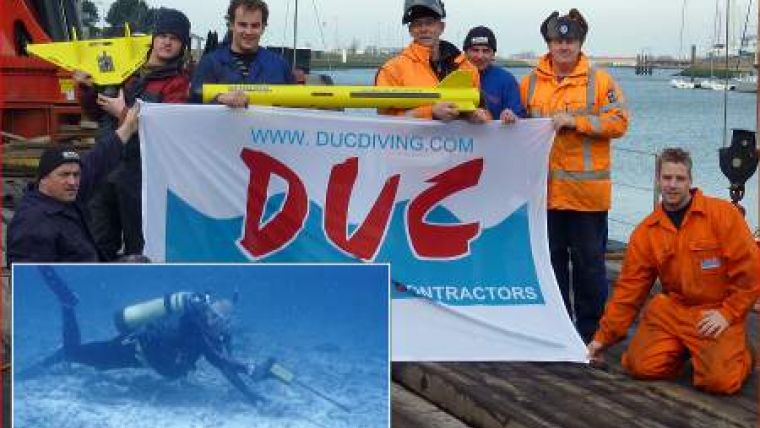Handheld Underwater Magnetometer
A diverse group of people from marine archaeologists to commercial divers are using a new compact, hand-held magnetometer designed to locate iron and steel objects underwater.
Based in The Netherlands, DUC Diving (image) has more than 25 years experience in commercial diving operations and an established reputation for successful and timely completion of projects. The company offers a range of services in underwater work including technical support, engineering, and inspections. Last year DUC added a Fisher side-scan sonar to their extensive line of equipment in order to perform a survey operation. "We were very pleased with the sonar's performance and the support of Fishers team", says DUC Diving's owner Henk Kapitein. "When another job came up that required a magnetometer, we chose the PT-1 knowing it would be rugged and reliable." Using the hand-held mag DUC's team of underwater specialists was able to locate and mark the position of a pipeline running under the seafloor to prevent it from being damaged during a dredging operation. Divers not only tracked the route of the pipe, but also found and removed a number of junk objects from the ocean bottom that could have damaged the dredge.
Another company having great success with this instrument is Cosmos Agencia Maritima based in Peru. They provide a broad range of services to their clients including ship husbandry, cargo transportation and storage, machinery and equipment rental, supply of fuel and parts, and diving services. A common request they receive is for underwater inspections of hulls, propellers, and bow thrusters. While performing repair work, a diver may drop a part or tool, which quickly disappears into the silty bottom.
When this happens, an underwater metal locator is required to find the missing item. Cosmos recently procured a JW Fishers PT-1 pipe tracking magnetometer for their search and recovery projects. Francisco Paolillo Tapia, manager of special operations, reports the PT-1 is excellent for finding anchors, chains and other objects buried in the seabed. "This instrument helps us find the missing part quickly. Our divers used to spend a lot of time probing the muddy bottom searching for a lost tool or anchor. Now they find it fast using the mag, which saves us time and money."
North Carolina's Department of Cultural Resources (NCDCR) was established in the early 1970s with a varied mission that includes preserving the state's historical and cultural resources. A high profile project being undertaken by NCDCR's Underwater Archaeology Branch is the recovery of artifacts from the wreck site of Blackbeard's flagship, Queen Anne's Revenge. One of the instruments the team is employing is the PT-1. A key advantage of this magnetometer is its ability to pinpoint artifacts in areas that may be strewn with many iron and steel targets. Other mags can have trouble differentiating between the multiple pieces of ferrous metal on a wreck, making it nearly impossible to pinpoint individual targets. This hand-held magnetometer is the ideal tool to locate all of the ferrous objects at the site including anchors and chains, cannons, cannon balls, ship's stoves, and the iron hardware used in construction of the vessel. The first anchor from the Queen Anne's Revenge was recently raised from the muddy bottom where it had by lying for the last 300 years.














